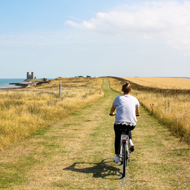We know that the road to reaching any goal starts with a step. And, when it comes to your personal fitness, your first step may be on a walking path, along a beach, on a treadmill, or even standing in place. As long as you’re using your own energy to move—whether running, walking, swimming, kickboxing, or riding a bike—you are on the road to fitness.
And, making small, incremental changes in your daily habits can help you become healthier, stronger, and help you stay more active as you age.
Four for Fitness
Being fit involves four key factors – it encompasses your aerobic capacity (endurance), strength, balance, and flexibility. The National Institutes of Health has developed a fitness program that focuses on these four key areas.
- Endurance activities increase your breathing and heart rate. Also known as aerobic or cardio exercise. Endurance activity improves the health of your heart, lungs, and circulatory system and can delay or prevent many diseases. Endurance activities include walking, biking, running, dancing, swimming, and climbing stairs.
- Strength exercises work all the major muscle groups - legs, hips, back, chest, stomach, shoulders, and arms. Strengthening activities include weights, circuit training, using resistance bands, swimming, calisthenic and mat exercises.
- Balance (agility) exercises are important because they help stabilize core muscles, improving balance. Good balance and agility tend to deteriorate with age, so it’s important to maintain and improve good balance in order to prevent falls and broken bones. Exercises to improve balance include Tai Chi, yoga and Pilates.
- Flexibility and stretching exercises can help your body stay limber and give you more freedom of movement. Flexibility activities include yoga and stretching exercises.
Many exercises help with more than one of these categories. For instance, strengthening exercises performed in a circuit (also known as interval training) will also provide endurance (or cardio) exercise.
The Benefits of Being Fit
Regular physical activity can produce long-term health benefits by helping to:
- Prevent chronic diseases such as heart disease, cancer, and stroke (the three leading health-related causes of death)
- Control weight
- Strengthen your muscles
- Reduce body fat
- Promote joint development
- Strengthen bones
- Condition heart and lungs
- Build overall strength and endurance
- Improve sleep
- Decrease potential of becoming depressed
- Increase your energy and self-esteem
- Relieve stress
- Increase your chances of living longer
See National Institutes of Health for more information.
